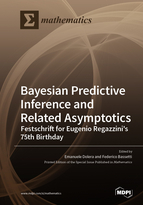Bayesian Predictive Inference and Related Asymptotics—Festschrift for Eugenio Regazzini's 75th Birthday
A special issue of Mathematics (ISSN 2227-7390).
Deadline for manuscript submissions: closed (15 January 2022) | Viewed by 18460
Special Issue Editors
Interests: bayesian inference; species sampling models; empirical processes; bayesian consistency; limit theorems of probability theory
Special Issue Information
Dear Colleagues,
To make reliable predictions, based on observed data, is one of the major tasks in probability and statistics. To this end, the Bayesian approach is possibly the natural one. However, there are still various issues which need further investigation. Just to mention a few: (i) In addition to exchangeability, what dependence structures are suitable for prediction ? (ii) Is it possible to make Bayesian predictions without involving the usual prior/posterior scheme ? (iii) What about the asymptotic behavior of predictive distributions ? (iv) In particular, what is the convergence rate of the distance between empirical and predictive measures ? This special issue aims to collect some recent papers on (i)-(iv) and related topics, paying special attention to the asymptotic problems.
Dr. Emanuele Dolera
Dr. Federico Bassetti
Guest Editors
Manuscript Submission Information
Manuscripts should be submitted online at www.mdpi.com by registering and logging in to this website. Once you are registered, click here to go to the submission form. Manuscripts can be submitted until the deadline. All submissions that pass pre-check are peer-reviewed. Accepted papers will be published continuously in the journal (as soon as accepted) and will be listed together on the special issue website. Research articles, review articles as well as short communications are invited. For planned papers, a title and short abstract (about 100 words) can be sent to the Editorial Office for announcement on this website.
Submitted manuscripts should not have been published previously, nor be under consideration for publication elsewhere (except conference proceedings papers). All manuscripts are thoroughly refereed through a single-blind peer-review process. A guide for authors and other relevant information for submission of manuscripts is available on the Instructions for Authors page. Mathematics is an international peer-reviewed open access semimonthly journal published by MDPI.
Please visit the Instructions for Authors page before submitting a manuscript. The Article Processing Charge (APC) for publication in this open access journal is 2600 CHF (Swiss Francs). Submitted papers should be well formatted and use good English. Authors may use MDPI's English editing service prior to publication or during author revisions.
Keywords
- bayesian nonparametrics
- conditional identity in distribution
- empirical bayes methods
- empirical measure
- exchangeability
- gibbs measures
- polya-urn sequence
- predictive measure
- species sampling models
- stable convergence
- total variation distance






